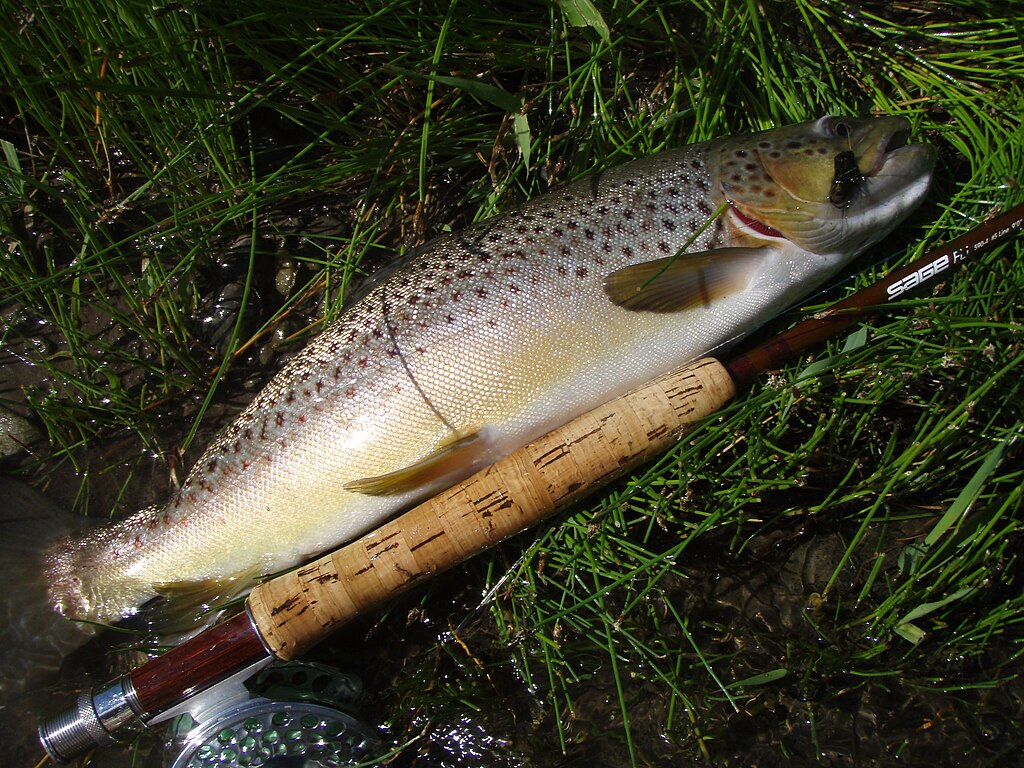
Brown Trout
Scientific Name: Salmo trutta
Also known as: European Brown Trout, German Brown, Sea Trout
General Description
The Brown Trout is a popular and prized species among anglers, known for its elusive nature and stunning coloration. Native to Europe, the species has been introduced across North America, where it thrives in cool, clear rivers and lakes. Brown Trout have a streamlined, torpedo-like body with a brownish-yellow hue, often with spots and markings in shades of black or red. These spots vary in size, with some individuals having very few and others covered in spots across their entire body.
Brown Trout are one of the most adaptable freshwater fish species, capable of living in a variety of habitats, from cold mountain streams to larger lakes. They can grow to impressive sizes, with some individuals exceeding 30 pounds in weight, though the average size is typically much smaller, ranging from 10 to 20 inches. Unlike other trout species, Brown Trout are opportunistic feeders and can be found in both fast-moving rivers and deeper lakes. Their ability to adapt to different environments makes them a favorite target for anglers seeking a challenge.
They are often considered more difficult to catch compared to other species, as they tend to be more cautious and selective when feeding. This makes them an ideal species for those looking for a more rewarding fishing experience.
Where to Find Them
Brown Trout are found in a variety of freshwater environments, ranging from cold mountain streams to large lakes, with populations established across the U.S. and Canada. They thrive in clean, clear waters with plenty of oxygen and abundant food sources. In general, they prefer waters with a temperature range of 50°F to 60°F, although they can tolerate warmer waters in certain conditions.
Rivers and streams with a combination of fast-moving riffles and deep pools are prime habitats for Brown Trout, as these areas offer both feeding opportunities and shelter. During the warmer months, Brown Trout are often found in deeper, cooler parts of lakes and reservoirs, especially in areas with abundant vegetation and submerged structures. As opportunistic feeders, they tend to move throughout the water column depending on food availability, often stalking minnows, crayfish, and insects.
Brown Trout are also found in both wild and stocked populations. While wild Brown Trout are often more challenging to catch due to their wariness and natural behavior, stocked Brown Trout can be found in many public lakes and rivers, particularly in regions where they have been introduced for sport fishing purposes.
Best Baits
Live Bait Options
- Minnows
- Nightcrawlers
- Crayfish
- Worms (earthworms or red worms)
- Small baitfish
Artificial Bait Options
- Streamer flies (black or olive)
- Crankbaits (natural fish colors)
- Soft plastics (shad or minnow imitations)
- Spinners (silver or gold)
- Jigs (dark or natural colors)
Best Fishing Methods
Brown Trout are often considered one of the most difficult species to catch due to their wariness and selective feeding habits. As such, anglers must employ a variety of techniques to land this challenging fish. Fly fishing is one of the most popular methods, particularly when using streamer flies or dry flies that imitate the natural insects Brown Trout feed on. Using a lightweight fly rod and casting near submerged structures or riffles is an effective strategy, as Brown Trout tend to feed in both fast-moving and slower water.
For anglers targeting Brown Trout in lakes or larger reservoirs, trolling with small minnow or shad imitations can be highly effective. Crankbaits or soft plastics that resemble the fish’s natural prey can trigger strikes from Brown Trout, especially when retrieved at varying speeds. Anglers can also use spinners and inline spinners to attract Brown Trout when fishing in rivers and streams, particularly during the early morning or late evening when the fish are most active.
Another popular method for catching Brown Trout is bank fishing with live bait, particularly worms or crayfish. A simple bobber rig or bottom fishing setup with a small hook and live bait can be effective in deep pools or areas with submerged structures. Patience is key, as Brown Trout can be more hesitant to bite compared to other species. The best times to fish for Brown Trout are during low-light conditions, such as early mornings or evenings, when the fish are more active and willing to feed.
Summary
Fishing for Brown Trout offers a rewarding experience for anglers who enjoy a challenge. Known for their cautious and selective feeding behavior, these fish require skill and patience to catch. Brown Trout thrive in cool, clear waters with plenty of oxygen, and they can be found in rivers, streams, lakes, and reservoirs. The best time to target them is during the early morning or late evening hours, when they are most likely to feed actively.
Whether you’re fly fishing, trolling, or using live bait, Brown Trout are known for their wariness and can be difficult to catch. Techniques like using streamer flies or soft plastics that imitate minnows or crayfish are particularly effective. For anglers who prefer bank fishing, live worms and crayfish are great options to lure in this beautiful species. With their preference for cool, well-oxygenated waters, Brown Trout can be found in a wide range of habitats, making them an exciting and challenging fish to pursue.
Although they are often more elusive than other trout species, catching a Brown Trout is considered a great achievement among anglers. Whether fishing in rivers, lakes, or reservoirs, the Brown Trout offers an unforgettable experience for those looking for a challenge and a beautiful fish to catch.


